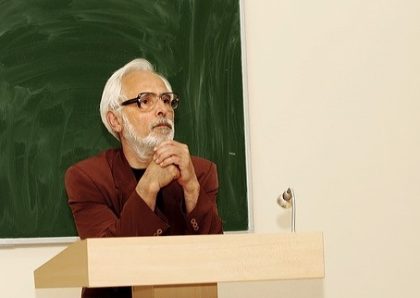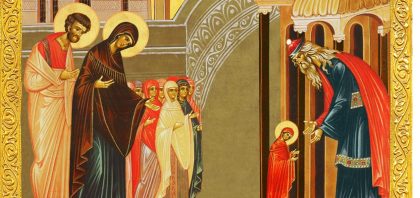Steve Jobs, the visionary in the black turtleneck who co-founded Apple in a Silicon Valley garage, built it into the world’s leading tech company and led a mobile-computing revolution with wildly popular devices such as the iPhone, died Wednesday. He was 56.
 The hard-driving executive pioneered the concept of the personal computer and of navigating them by clicking onscreen images with a mouse. In more recent years, he introduced the iPod portable music player, the iPhone and the iPad tablet – all of which changed how we consume content in the digital age.
The hard-driving executive pioneered the concept of the personal computer and of navigating them by clicking onscreen images with a mouse. In more recent years, he introduced the iPod portable music player, the iPhone and the iPad tablet – all of which changed how we consume content in the digital age.
More than one pundit, praising Jobs’ ability to transform entire industries with his inventions, called him a modern-day Leonardo Da Vinci.
„Steve Jobs is one of the great innovators in the history of modern capitalism,“ New York Times columnist Joe Nocera said in August. „His intuition has been phenomenal over the years.“
Jobs’ death, while dreaded by Apple’s legions of fans, was not unexpected. He had battled cancer for years, took a medical leave from Apple in January and stepped down as chief executive in August because he could „no longer meet (his) duties and expectations.“
Born February 24, 1955, and then adopted, Jobs grew up in Cupertino, California – which would become home to Apple’s headquarters – and showed an early interest in electronics. As a teenager, he phoned William Hewlett, president of Hewlett-Packard, to request parts for a school project. He got them, along with an offer of a summer job at HP.
obs dropped out of Oregon’s Reed College after one semester, although he returned to audit a class in calligraphy, which he says influenced Apple’s graceful, minimalist aesthetic. He quit one of his first jobs, designing video games for Atari, to backpack across India and take psychedelic drugs. Those experiences, Jobs said later, shaped his creative vision.
„You can’t connect the dots looking forward; you can only connect them looking backwards. So you have to trust that the dots will somehow connect in your future,“ he told Stanford University graduates during a commencement speech in 2005. „You have to trust in something: your gut, destiny, life, karma, whatever. This approach has never let me down, and it has made all the difference in my life.“
While at HP, Jobs befriended Steve Wozniak, who impressed him with his skill at assembling electronic components. The two later joined a Silicon Valley computer hobbyists club, and when he was 21, Jobs teamed with Wozniak and two other men to launch Apple Computer Inc.

It’s long been Silicon Valley legend: Jobs and Wozniak built their first commercial product, the Apple 1, in Jobs’ parents’ garage in 1976. Jobs sold his Volkswagen van to help finance the venture. The primitive computer, priced at $666.66, had no keyboard or display, and customers had to assemble it themselves.
The following year, Apple unveiled the Apple II computer at the inaugural West Coast Computer Faire. The machine was a hit, and the personal computing revolution was under way.
Jobs was among the first computer engineers to recognize the appeal of the mouse and the graphical interface, which let users operate computers by clicking on images instead of writing text.
Apple’s pioneering Macintosh computer launched in early 1984 with a now-iconic, Orwellian-themed Super Bowl ad. The boxy beige Macintosh sold well, but the demanding Jobs clashed frequently with colleagues, and in 1986, he was ousted from Apple after a power struggle.
Then came a 10-year hiatus during which he founded NeXT Computer, whose pricey, cube-shaped computer workstations never caught on with consumers.
Jobs had more success when he bought Pixar Animation Studios from George Lucas before the company made it big with „Toy Story.“ Jobs brought the same marketing skill to Pixar that he became known for at Apple. His brief but emotional pitch for „Finding Nemo,“ for example, was a masterful bit of succinct storytelling.
In 1996, Apple bought NeXT, returning Jobs to the then-struggling company he had co-founded. Within a year, he was running Apple again – older and perhaps wiser but no less of a perfectionist. And in 2001, he took the stage to introduce the original iPod, the little white device that transformed portable music and kick-started Apple’s furious comeback.
Thus began one of the most remarkable second acts in the history of business. Over the next decade, Jobs wowed launch-event audiences, and consumers, with one game-changing hit after another: iTunes (2003), the iPhone (2007), the App Store (2008), and the iPad (2010).
Observers marveled at Jobs’ skills as a pitchman, his ability to inspire godlike devotion among Apple „fanboys“ (and scorn from PC fans) and his „one more thing“ surprise announcements. Time after time, he sold people on a product they didn’t know they needed until he invented it. And all this on an official annual salary of $1.
He also built a reputation as a hard-driving, mercurial and sometimes difficult boss who oversaw almost every detail of Apple’s products and rejected prototypes that didn’t meet his exacting standards.
By the late 2000s, his once-renegade tech company, the David to Microsoft’s Goliath, was entrenched at the uppermost tier of American business. Apple now operates more than 300 retail stores in 11 countries. The company has sold more than 275 million iPods, 100 million iPhones and 25 million iPads worldwide.
Jobs’ climb to the top was complete in summer 2011, when Apple listed more cash reserves than the U.S. Treasury and even briefly surpassed Exxon Mobil as the world’s most valuable company.
But Jobs’s health problems sometimes cast a shadow over his company’s success. In 2004, he announced to his employees that he was being treated for pancreatic cancer. He lost weight and appeared unusually gaunt at keynote speeches to Apple developers, spurring concerns about his health and fluctuations in the company’s stock price. One wire service accidentally published Jobs’ obituary.
Jobs had a secret liver transplant in 2009 in Tennessee during a six-month medical leave of absence from Apple. He took another medical leave in January this year. Perhaps mindful of his legacy, he cooperated on his first authorized biography, scheduled to be published by Simon & Schuster in November.
Jobs is survived by his wife of 20 years, Laurene, and four children, including one from a prior relationship.
He always spoke with immense pride about what he and his engineers accomplished at Apple.
„Your work is going to fill a large part of your life, and the only way to be truly satisfied is to do what you believe is great work. And the only way to do great work is to love what you do,“ he told the Stanford grads in 2005.
„If you haven’t found it yet, keep looking. Don’t settle. As with all matters of the heart, you’ll know when you find it. And, like any great relationship, it just gets better and better as the years roll on.“
http://www.cnn.com/2011/10/05/us/obit-steve-jobs/
Timeline
1970s
1974: Video game designer for Atari; worked there several months; used savings to travel to India; returned to California and spent a brief time on a communal farm.
1975: Attended meetings of the Homebrew Computer Club in Palo Alto, Calif., attended by friend and engineering genius, Stephen Wozniak; they joined forces and built a marketable table-top computer in Jobs’ parents’ garage; co-founded Apple Computer Inc.
1976: Introduced Apple I computer for $666; first single-board computer with onboard Read Only Memory (ROM) that told the machine how to load programs from an external source and had a video interface.
1977: Introduced Apple II; first mass-marketed personal computer; had a plastic case and included color graphics; Jobs encouraged programmers to create applications for the Apple II; this resulted in 16,000 programs from games to farm budgets; former Intel marketing manager Mike Markkula became Apple chairman and secured venture capital of $600,000.
1979: Development of a computer named Lisa, which would redefine personal computing; Jobs removed as project manager; he began working on the Macintosh personal computer.
1980s
1980: Initial public offering of Apple; market value of company rose to $1.2 billion; Apple III introduced with eight applications, including text and graphics; initial problems forced a recall; once fixed, it became popular with professional customers; situation created a management shakeup; Markkula became president, Jobs became chairman.
1981: Stephen Wozniak took leave of absence after being injured in a private plane crash; IBM sold its first personal computer, four years after Apple II; Apple’s sales continued to rise
1983: Public debut of Lisa, a powerful, more intuitive computer controlled by hand-held mouse; designed for computer illiterate; smaller, less expensive version called Macintosh also introduced; Jobs recruited former PepsiCo President John Sculley as new Apple president and CEO.
1985: Jobs essentially ousted from Apple in a boardroom coup after a power struggle with Sculley; resigned with $150 million but personally hurt; formed NeXT Software to develop computer hardware and software; Microsoft sold its first Windows 1.0 operating system
1986: Bought Pixar computer animation studios from George Lucas for less than $10 million 1989: NeXT produced a powerful but expensive computer, which was rejected by the arketplace; Pixar won an Academy Award for computer-animated film „Tin Toy“
1990s
1993: Still unprofitable NeXT ended hardware division to focus on software for programmers and building Internet sites; Sculley resigned as CEO of Apple
1995: Walt Disney Pictures released Pixar’s first feature film, „Toy Story,“ first animated feature created entirely on computer; was highest domestic grossing film that year
1996: Jobs contacted Apple; Apple acquired NeXT; Jobs returned as non-salaried adviser to chairman Gilbert F. Amelio
1997: Apple’s revenues dropped significantly; Jobs negotiated deal with longtime competitor Bill Gates of Microsoft; Apple made deal to include Microsoft’s Internet Explorer browser on Macintosh operating system; Microsoft agreed to invest $150 million of non-voting Apple stock and to develop Mac versions of popular Microsoft Office software; Amelio ousted by Apple board; Jobs offered CEO and chairman position, and he agreed to serve on an interim basis
1998: Apple Computer rebounded with three profitable quarters in a row
Quotes
„I was lucky to get into computers when it was a very young and idealistic industry. There weren’t many degrees offered in computer science, so people in computers were brilliant people from mathematics, physics, music, zoology, whatever. They loved it, and no one was really in it for the money.“
(Fortune)
„The personal computer was created by the hardware revolution of the 1970s. The next change will come from a software revolution.“
(Current Biography)
„The Macintosh turned out so well because the people working on it were musicians, artists, poets and historians who also happened to be excellent computer scientists.“
(The New York Times)
„We started out to get a computer in the hands of everyday people, and we succeeded beyond our wildest dreams.“
(Time)
„I’m not a hostile-takeover kind of guy.“
(The New York Times)
„I am at a stage where I don’t have to do things just to get by. But then I’ve always been that way, because I’ve never really cared about money that much.“
(Fortune)
„Woz[niak] was the first person I met who knew more about electronics than I did.“
About Jobs: „Like the Bhagwan, driving around Rancho Rajneesh each day in another Rolls-Royce, Jobs kept his troops fascinated and productive. The joke going around said that Jobs had a ‘reality distortion field’ surrounding him. He’d say something, and the kids in the Macintosh division would find themselves replying ‘Drink poison Kool-Aid? Yeah, that makes sense.“
Robert X. Cringely, 1992.
Fun Facts
Mr. Jobs purchased the computer division of Lucasfilm, Ltd. in 1986 and incorporated it as an independent company under the name Pixar.
He was co-founder, chairman and chief executive officer of NeXT Software, Inc. NeXT Software was sold to Apple Computer in February 1997.
Before founding NeXT, Mr. Jobs co-founded and was chairman of Apple Computer, Inc. He guided Apple as it grew to a $2 billion company, during which time he co-designed the Apple II and led the development, manufacturing and marketing of the Macintosh and LaserWriter printer.
In recognition of his pioneering work in technology, he was awarded the National Technology Medal by President Reagan in 1985 and the Jefferson Award for Public Service in 1987. In 1989, he was named Entrepreneur of the Decade by Inc. magazine.
Brushes with Fame: Dated Joan Baez in his 20s; Ella Fitzgerald sang at his 30th birthday party; entertained President Clinton at his home in Palo Alto, Calif.
Apple Stock Holdings: Now owns only a symbolic one share; he’s paid $1 a year from Apple so that he can be on the health plan.
Email: Receives about 300 per day.
Raising Early Capital: After receiving an order for 25 Apple I computers, Jobs and Wozniak raised needed capital by selling Jobs’ Volkswagen van and Wozniak’s Hewlett-Packard scientific calculator
Phenomenal Growth: Sales of Apple II computer in the late 1970s totaled $139 million after three years, growing by 700 percent.
Steve Jobs’ 2005 Stanford Commencement Address
Самая знаменитая речь Стива Джобса произнесенная выпускникам Стенфорда в 2005 году (русский перевод).
http://youtu.be/TzWc7VBmTPI







Грандиозен е. Невероятен е дизайнът на сгъваемото щепселче и трансформаторчето за лаптоп-а. И магнита на USB – тата, които буквално ЛЕПНАТ за компютъра ти. А убийствено красивят бял лаптоп? Финяшки и лек като перце. Най-голямата изненада е, че са произведени в Китай. Явно с много взискателност и строг контрол.
Мир на праха на този велик човек.